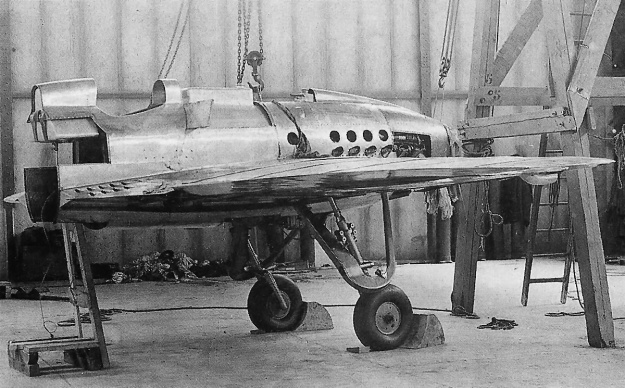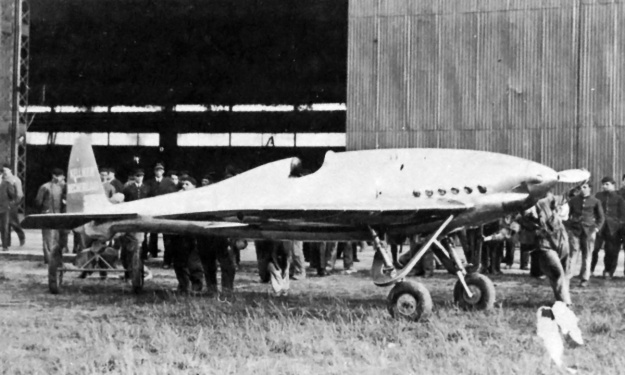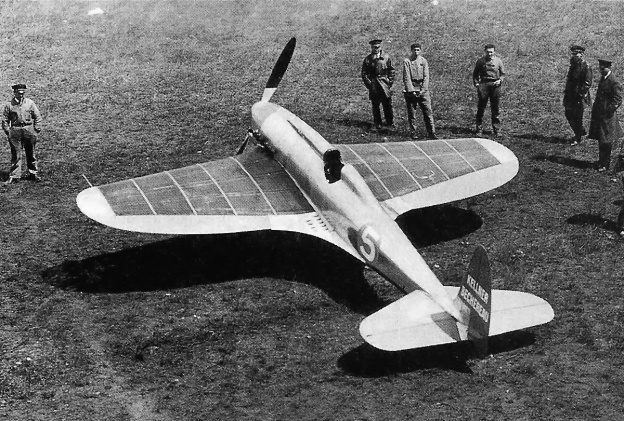By William Pearce
Société Kellner was a French luxury coachbuilder run by Georges Kellner. During World War I, the company turned to producing SPAD VII, S.XI, and S.XIII fighter aircraft under license. The SPAD (Société Pour L’Aviation et ses Dérivés / Company for Aviation and its Derivatives) aircraft were designed by French aeronautical engineer Louis Béchereau. After World War I, Société Kellner returned to coach making, and SPAD went out of business. Béchereau progressed through a number of companies until 1926, when he founded the Société pour la Réalisation d’Avions Prototypes (SRAP / Prototype Aircraft Company).

The Kellner-Béchereau 28VD under construction. The cowling attached to the very front of the aircraft contained the surface oil cooler. The top of the coolant tank is visible just behind the fairing atop the engine. Note the fuel tanks forward and aft of the cockpit.
Société Kellner was taken over by Jacques Kellner after his father’s passing. Jacques was an aviation enthusiast and wanted to steer the company back to being involved with aviation. In 1931, Jacques Kellner joined forces with Louis Béchereau to form Avions Kellner-Béchereau in Boulogne-Billancourt, France. Kellner-Béchereau immediately began designing aircraft, and one of their first concepts was that of the 28VD (also known as KB-28), an air racer intended for the 1933 Coupe Deutsch de la Meurthe. The Coupe Deutsch de la Meurthe was a race to cover 1,242 miles (2,000 km) with a mandatory 90-minute stop at 621 miles (1,000 km), and aircraft were limited to using a single engine with a displacement no greater than 488 cu in (8.0 L). Additional stops could be made but were not mandatory and would count against the total time to finish the course. Ten laps of the 124-mile (200-km) course would complete the race, and the rhombus-shaped course was laid out with towns of Chartres, Moisy, Orléans, and Étampes at its corners. The Étampes-Mondésir airfield was the start and finish point, and the prize in 1933 was four million Francs.
The Kellner-Béchereau 28VD was a low-wing taildragger made almost entirely of metal, and its design was tested in a wind tunnel. The aircraft’s slim monocoque fuselage was of all-aluminum construction with an open cockpit at its center. A sloped fairing led up to the cockpit, and an extended headrest trailed from it. This resulted in the pilot sitting rather low with little forward visibility, but side visibility was quite good. Fuel tanks were housed in front of and behind the cockpit. The aircraft’s vertical and horizontal stabilizers were made of aluminum, but the rudder and elevators were made of wood. The angle of the horizontal stabilizers was adjustable and could be altered to trim the aircraft while in flight. An aerodynamic fairing partially covered the tailskid.

The 28VD undergoing final touches. This image gives a good view of how the surface radiators wrapped around the wing’s leading edge. Note the large Ratier metal propeller. Intakes to the engine’s superchargers can just been seen on the cowling’s undersides.
The relatively-short, cantilever wings of the 28VD were attached to the fuselage by a main spar at its center and a rear spar. The wings were further supported by false front and rear spars. A large aileron ran almost the entire length of the wing’s trailing edge and was attached to the false rear spar. Wing construction kept its interior mostly open, and three fuel tanks were positioned in each wing. Each of the wing tanks was equipped with a quick-drain dump valve 3.94 in (10 cm) in diameter. For the valve, carbonic acid gas was fed into a space that blew out a lower seal, allowing an upper plug to fall free followed by the contents of the fuel tank. Although not specifically stated, it is presumed that the pilot would control the flow of the carbonic acid gas to initiate the fuel dump. It is not clear if the fuselage tanks were also equipped with a dump valve.
The upper surface of each wing was covered with radiators in five sections. Each surface radiator section consisted of a forward and rear part. The front radiator for each section curved around the front of the wing to form the leading edge. The inner three radiator sections terminated shortly after making the turn to the wing’s underside. The outer two sections continued around the leading edge to cover the front half of the underwing, and additional radiators covered the rear outer surface under the wing. Water from the coolant tank installed above the engine flowed through pipes in the wing’s leading and trailing edges and then into the surface radiators. After passing through the radiator, the cooled water was collected in a tube running along the center spar and returned to the engine. A large fairing connecting the wing’s trailing edge to the fuselage contained a number of louvers to allow heat, vapors, and moisture to escape from the wing.

The newly completed 28VD is rolled out of the hangar for testing. The aircraft’s streamlining and slim fuselage are apparent. This image provides a good view of the landing gear’s arched supports. For retraction, the top of the gear leg slid toward the wingtip, and the lower gear leg pivoted around the arched support.
Mounted under the inboard sections of the wings was the partially-retractable main landing gear, which had a 4 ft 10 in (1.48 m) track. When extended, a fixed ball at the top of each gear leg was locked into place, and the leg itself was supported by an arched member attached to the fuselage. The ball atop the gear leg was mounted in a channel in the wing. To retract the gear, a retraction lever released the downlock and bled pressure in a cylinder, which unlocked a drum and allowed a cable to unwind. As the gear leg pivoted around its arched support, an elastic cable pulled the top of the gear leg toward the wing tip until the gear leg rested against the underside of the wing. An uplock under the inner wing secured the gear leg in the retracted position, and the arched support provided a crude aerodynamic fairing. To extend the gear, an extension lever released the uplock and fed pressurized air into a cylinder. The piston in the cylinder rotated a drum which wound a cable. The cable was attached to the upper gear legs and pulled them inboard against the tension of the elastic cable. Once the cable had pulled the gear to its extended position, the ball atop the gear leg was secured by the downlock.
Housed in a streamlined, close-fitting cowling at the front of the 28VB was the Delage 12 CDirs engine. Built by la Société des Automobiles Delage (the Delage Automobile Company), the engine was specially made for the Coupe Deutsch de la Meurthe race. Its “12 CDirs” designation stood for 12 cylinders, Coupe Deutsch, inverse (inverted), réducteur (gear reduction), and suralimenté (supercharged). The 400 hp (298 kW) engine was a water-cooled V-12 with twin-Roots superchargers. The 12 CDirs had a 3.94 in (100 mm) bore, a 3.31 in (84 mm) stroke, and a displacement of 483 cu in (7.92 L). Intakes in each side of the lower cowling brought in air to the engine’s superchargers. Exhaust was expelled through individual stacks protruding from the cowling. A saddle water tank sat atop the rear part of the engine. A U-shaped oil tank was installed between the engine and the propeller. A surface oil cooler was positioned atop the engine and covered the area between the water tank and the spinner. The engine turned a two-blade, metal, ground-adjustable Ratier propeller that was approximately 7 ft 9 in (2.37 m) in diameter.

Elevated view of the 28VD illustrates the surface radiators covering the upper wings. Note the vents in the wing’s trailing edge fairing. The race number “5” has been applied to the fuselage. This image was most likely taken on 14 May 1933, the day of the accident, as the aircraft is prepared for its qualification flight.
The Kellner-Béchereau 28VD had a wingspan of 21 ft 10 in (6.65 m), a length of 23 ft 6 in (7.16 m), and a height of 8 ft 8 in (2.64 m). The aircraft weighed 2,176 lb (987 kg) empty and 3,527 lb (1,600 kg) fully loaded. The 28VD had an anticipated top speed of 249 mph (400 km/h) and a cruising speed of 214 mph (345 km/h). On 5 May 1933, the aircraft was moved to the Étampes-Mondésir airfield where it would be completed for the Coupe Deutsch de la Meurthe, to be held on 28 May. Qualifying for the race was scheduled 8–14 May, which left very little time for flight testing. The 28VD was given race number 5 and made its first flight on 12 May. Armée de l’Air Capitaine Maurice Vernhol conducted the very brief flight tests, which did not reveal any issues, and would fly the 28VD for the race. Refining and preparing the aircraft used up most of the qualifying time. Based on previous tests, Vernhol felt that the engine’s full power was not being utilized and requested that the propeller be adjusted to a finer pitch.
During an afternoon qualification flight on 14 May 1933, Vernhol added full power, and the engine revved to an excess of 4,400 rpm—over 600 rpm more than its maximum limit. At that moment, a coolant hose blew free from its mount, and Vernhol was enveloped in a shower of steam and hot water. It is not clear if the increased coolant pressure from the engine overspeed caused the hose to blow free, or if it was just bad timing. Regardless, Vernhol was blinded by the spray and attempted an emergency landing near Ville Sauvage, north of the Étampes-Mondésir airfield. In his impaired condition, Vernhol misjudged the landing, and the 28VD hit the ground hard. The extended landing gear broke off, and the aircraft flipped upside down, tearing off the engine and breaking the fuselage behind the cockpit. Amazingly, Vernhol escaped with only minor injuries, but the 28VD was completely destroyed. A Potez 53 flown by Georges Détré went on to win the 1933 Coupe Deutsch de la Meurthe at a speed of 200.58 mph (322.81 km/h).
Kellner-Béchereau also designed a fighter along the same lines as the 28VD / KB-28. Known as the KB-29, the fighter was powered by a 550 hp (410 kW), 731 cu in (11.97 L) Delage 12 GVis inverted V-12 engine. The engine was displayed at the 1932 Paris Salon de l’Aéronautique, but the KB-29 fighter never materialized.

The remains of the 28VD after its forced lading. The landing gear and engine have been ripped away, and the fuselage is broken at a right angle behind the wing. The surface radiators under the outer wing are visible. The circular openings seen in the wing’s underside are the dump valves for two of the three fuel tanks.
Sources:
– “Les avions de la Coupe Deutsch de la Meurthe 1933” by Pierre Léglise, L’Aéronautique No 171 (August 1933)
– “L’éphémère Kellner-Bechereau KB 28” by Robert J. Roux, Le Fana de l’Aviation No 253 (December 1990)
– “Le Kellner-Béchereau 28V.D.” by Michel Marrand, L’Album du Fanatique de L’Aviation 23 (June 1971)
– “Le Coupe Deutsch de la Meurthe” by L. Hirschauer, L’Aérophile 14 Annee No 6 (June 1933)
– “The 1933 Contest for the Deutsch de la Meurthe Trophy” by Pierre Léglise, L. Hirschauer, and Raymond Saladin, National Advisory Committee for Aeronautics Technical Memorandum No. 724 (October 1933)
– https://www.secretprojects.co.uk/threads/kellner-bechereau-project.32989/
– https://www.secretprojects.co.uk/threads/louis-b%C3%A9chereau-designations.26384/
– https://en.wikipedia.org/wiki/Kellner-B%C3%A9chereau_28VD
– https://www.aviafrance.com/kellner-bechereau-28vd-aviation-france-891.htm


Sad end to a great looking aircraft.
Great article.
An elegant but unlucky aircraft.
Thank you for posting.